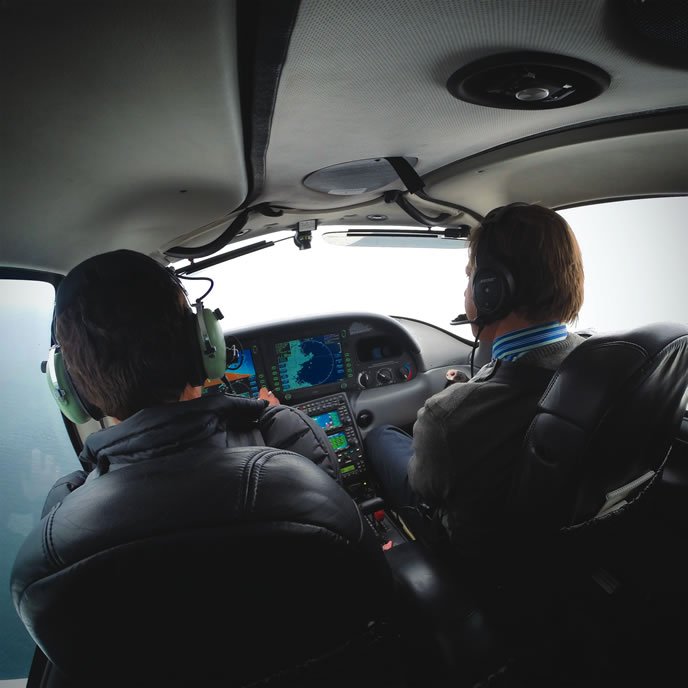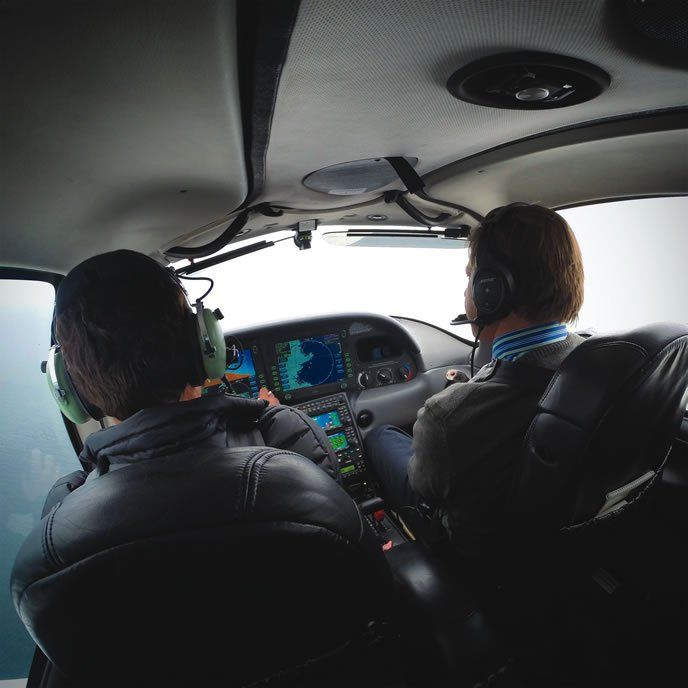I’ve never felt it appropriate that a pilot could obtain an instrument rating without flying in clouds. From a safety standpoint, it seems ludicrous. I received instrument dual in IMC and have done my best to make sure my instrument students get experience in the clag before taking their checkride. Nevertheless, I recognize that there are flight schools and instructors who will not give dual in IMC for various reasons. Over the years, I’ve spoken with a number of them about the issue.

The common denominator in those conversations combines not wanting to risk the student losing control of the airplane in clouds and having a very compact syllabus designed to herd pilots through the instrument rating as quickly as possible. In some cases, training organizations tell me they face overwhelming pressure from customers to put the checks in the boxes and get the rating as fast as possible, without concern for actually learning anything. I was told that taking time to do actual instrument work would interfere with the process. One instructor pointed out that the FAA would not give check rides in actual instrument weather and reiterated that there was no requirement in the FARs to get any time in the clag, so why should he give dual in IMC?
Bitter Experience
I’ve been involved in looking closely at far too many accidents over the years. Many occurred in instrument conditions and involved pilots with the rating but little actual time flying in clouds. We humans evolved on the surface of this planet and have only been creatures of the sky since we started flying balloons in 1783—in the scheme of things, a mere flicker of an eyelash of time. A tremendous amount of what we experience in flight is without parallel to our experiences on the ground. Our inbred, ground-based instincts and reactions get triggered by the sensations of flight and, unfortunately, they often are dead wrong when it comes to what is appropriate when moving about the sky. As a result, we have to learn nearly everything formally when we step into the third dimension. So, when first flying VFR, we go with flight instructors. I feel that when we first fly inside a cloud it’s also a wise idea to do so with flight instructors who can help us through this massive new set of experiences.
For example, it’s not a bad idea for an instructor to be there the first time a pilot actually sees how the color of the cloud changes as one nears the top, and that on an overcast day it’s wise to have sunglasses handy for that moment. Besides, having someone to share the exuberance you feel the first time you break out of the top of a cloud deck makes the moment even more magical. It’s also a good idea for future reference for an instructor to be there to point out how much further they had to climb beyond that point when the student felt they were “almost on top.”
At the other end of the flight, there is an emotional component to the descent through clouds as one discovers the ever-increasing—almost sinister—darkness as the bases are neared and the pilot feels the pressure build to keep the needles centered, knowing the cold, hard ground is close. Add the sometimes overpowering need to urinate nearing minimums and it’s not a bad idea that the first time be with someone who has been there before, even if only for moral support.
Telling instrument students that the worst ice is usually near cloud tops is no substitute for letting them discover it’s true. Many good things come from having an instructor along the first time the pilot watches the climb rate go to nothing over a period of a few minutes, especially when that pilot firmly believes that climbing just a few hundred feet more will put them on top. At that moment some gentle comments by an experienced instructor—such as pointing out that estimating where the tops are without a pilot report may not be a good idea—may make a long-lasting impression. In the event the pilot is still tempted to linger overlong in the icebox portion of a cloud due to inexperience, optimism about climb performance and a longing for sunlight, the instructor can take action before the pilot learns that a block of ice has poor aerodynamic qualities.
I’ve always heard the instrument rating described as the thinking rating. Listening to others far more competent than I, I’ve come to believe the process of developing the appropriate level of judgment to make good weather-related go/no-go decisions comes from having some degree of experience with weather.
The first time pilots I’ve trained are not sure if they are going to see the runway at the end of an approach, I’d like to be present, sitting quietly, just to be a safety net. When they spot the runway, make a play for it, drop the rest of the flaps, pull the power back and then lose sight of the runway, I would like to be in the other seat, watching. I know they are juggling the knowledge from books and our discussions that they must go missed, but I also know they feel in their guts that they can blow through this “little” cloud and get to the runway. That could be their last mistake.
Your First Time…
I want an experienced CFII in the right seat as a safety net, because I’ve looked at too many shredded airplanes and know that the particular decision those pilots are making right then means looking death in the face, and I want them alive. I don’t think books and lessons and lectures and hangar flying fully prepare a pilot for the overwhelming desire to land that comes about when a runway is glimpsed, even if only momentarily. Such an urge, if not resisted, can lead to either foolishly continuing a descent while in a “little” cloud or, perhaps even worse, trying to circle over a runway and land on it when the vertical visibility is 500 feet or so, and the horizontal visibility is about the same. Then, any turn they make will cause the runway, and all other visual references, to disappear.
I’m of the opinion that seeing such situations in circumstances where an instructor can prevent a bad decision from being fatal is more likely to lead to good decision-making by pilots once they have instrument ratings and are on their own. Bad weather makes a powerful impression on a pilot. Handling it correctly once makes it more likely it will be dealt with correctly in the future.
I want to fly in blowing snow with my students so that they can see how incredibly fast visibility can change and how a circle-to-land approach in it, or in any conditions at night, can provide food for the coffin worms.
An instructor friend told me that she firmly believed it was wise to fly with instrument students, in weather, at night, so that they can get a visceral understanding of the fact that it is often impossible to tell where the clouds are—something that is serious if there is ice about. She told the tale of the first time she was flying alone on a dark night and only realized she was in cloud when she heard a hissing noise and saw the windshield suddenly become opaque with rime ice, nearly necessitating a post-flight cleaning of the pilot’s seat upholstery.
Missing For Real
I’ve flown with instrument students when the weather was low enough to necessitate a real missed approach. The first real one usually causes distinct psychological reactions that can’t be duplicated in a simulator or under the hood. It takes an aircraft, clouds, uncertainty and cold sweat to accomplish that, and the first time is better with an instructor along.
There’s that awful moment when a pilot realizes she or he really isn’t going to succeed with the approach—and pilots are success driven. There is a serious reluctance to pitch up and initiate the missed approach. The process goes in stages and I’ve taken to comparing it to those described by Elisabeth K bler-Ross in her magnificent study, On Death and Dying. The pilot first denies that a missed approach is needed—the runway is going to appear even though we are at DA, or time has run out while at the MDA. Then, at varying rates, pilots go through the bargaining, promises and so forth she so artfully describes before acceptance sets in and the missed approach is tentatively begun. The fact the mental journey to acceptance and action can be required sometimes takes the pilot and the airplane well past the missed approach point is definite cause for concern.
I think it’s a good idea, if possible, to let instrument students encounter this whole process—denial through acceptance—for the first time with an instructor. I’ve met a number of instrument-rated pilots who tell me they’ve never had to fly a for-real missed approach. I worry a little for them, for I have been fortunate enough to learn about the dangerous mindset that develops when making instrument approaches in actual conditions—that each will result in a landing and the potentially deadly task continuation bias that goes with it.

At The Approach’s end
If possible, I also like to have a session shooting approaches with my instrument students when the weather is below the non-precision MDA, and a precision approach is available. It provides a real-world missed-approach opportunity. There’s also that wonderful feeling of shooting a precision approach to near minimums and getting in when the weather stinks. I think such sessions also help make the abstract notion of an alternate airport take on new meaning. It’s instructive because the ceiling or visibility would only have to drop a bit to make a diversion necessary, especially because they usually were flying an instrument trainer that didn’t have particularly long legs.
Near the end of an approach, transitioning to visual references by pulling off a hood is no big deal. That’s not the case in weather, especially when visibility is rotten: There’s no horizon and the cloud bases are ragged. Splitting one’s attention between the panel to keep the airplane upright and looking outside for the runway is a new and challenging experience. It’s caused more than a few pilots to hit the ground short of the runway. The FAA doesn’t require a demonstration of the ability to handle this transition in weather but, it seems to me, a good instructor will do the best he or she can to teach it to an instrument student.
It’s Up To You
I’m convinced that instructors can do a great deal for their instrument students by introducing them to flying in the clouds. While the FAA doesn’t require it, I believe an instructor should offer it to his or her students, and instrument students should demand it of their instructor.
Rick Durden is a CFII, holds an ATP, is an aviation attorney and the author of The Thinking Pilot’s Flight Manual, or How To Survive Flying Little Airplanes and Have a Ball Doing It, Vol. I.




